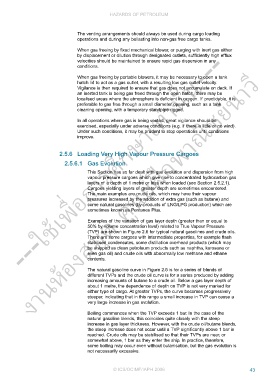Page 77 - International safety guide for oil tankers and terminals
P. 77
HAZARDS OF PETROLEUM
The venting arrangements should always be used during cargo loading
operations and during any ballasting into non-gas free cargo tanks.
2.5.6.1 Gas Evolutionึกษาเท่านั้น---
When gas freeing by fixed mechanical blower, or purging with inert gas either
by displacement or dilution through designated outlets, sufficiently high efflux
งานห้องสมุด ศูนย์ฝกพาณิชย์นาวี
velocities should be maintained to ensure rapid gas dispersion in any
conditions.
When gas freeing by portable blowers, it may be necessary to open a tank
hatch lid to act as a gas outlet, with a resulting low gas outlet velocity.
Vigilance is then required to ensure that gas does not accumulate on deck. If
an inerted tank is being gas freed through the open hatch, there may be
localised areas where the atmosphere is deficient in oxygen. If practicable, it is
preferable to gas free through a small diameter opening, such as a tank
cleaning opening, with a temporary standpipe rigged.
In all operations where gas is being vented, great vigilance should be
exercised, especially under adverse conditions (e.g. if there is little or no wind).
Under such conditions, it may be prudent to stop operations until conditions
improve.
---ใช้เพื่อการศ
2.5.6 Loading Very High Vapour Pressure Cargoes
ึ
This Section has so far dealt with gas evolution and dispersion from high
vapour pressure cargoes which give rise to concentrated hydrocarbon gas
layers of a depth of 1 metre or less when loaded (see Section 2.5.2.1).
Cargoes yielding layers of greater depth are sometimes encountered.
The main examples are crude oils, which may have their vapour
pressures increased by the addition of extra gas (such as butane) and
some natural gasolines (by-products of LNG/LPG production) which are
sometimes known as Pentanes Plus.
Examples of the variation of gas layer depth (greater than or equal to
50% by volume concentration level) related to True Vapour Pressure
(TVP) are shown in Figure 2.6 for typical natural gasolines and crude oils.
There are some cargoes with intermediate properties, for example flash
stabilised condensates, some distillation overhead products (which may
be shipped as clean petroleum products such as naphtha, kerosene or
even gas oil) and crude oils with abnormally low methane and ethane
contents.
The natural gasoline curve in Figure 2.6 is for a series of blends of
different TVPs and the crude oil curve is for a series produced by adding
increasing amounts of butane to a crude oil. Below a gas layer depth of
about 1 metre, the dependence of depth on TVP is not very marked for
either type of cargo. At greater TVPs, the curve becomes progressively
steeper, indicating that in this range a small increase in TVP can cause a
very large increase in gas evolution.
Boiling commences when the TVP exceeds 1 bar. In the case of the
natural gasoline blends, this coincides quite closely with the steep
increase in gas layer thickness. However, with the crude oil/butane blends,
the steep increase does not occur until a TVP significantly above 1 bar is
reached. Crude oils may be stabilised so that their TVPs are near, or
somewhat above, 1 bar as they enter the ship. In practice, therefore,
some boiling may occur even without butanisation, but the gas evolution is
not necessarily excessive.
© ICS/OCIMF/IAPH 2006 43

